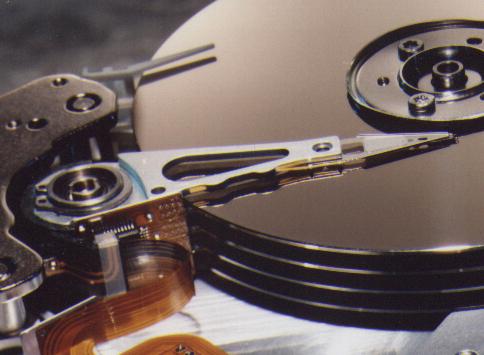|
|
P A G E T W O O F F I V E |
Advantages of Multi-Partition DrivesAdvantage #1: A hard drive containing multiple partitions allows you to *lower* your drive's effective access time, providing you with a more responsive system. If you create a partition at the outer/leading edge of your drive (*1), and install your operating system & applications there .. and use the inner/slower parts of the disk for storing files that don't require access during normal system operating (i.e. downloads, drivers, back-ups, Ghost images, etc.) .. you'll limit/restrict your drive's seeks to the fastest part of the drive. (*1) - the first partition you create on a drive will automatically take the outer/leading/fastest edge. Here's a photo of a hard drive's intenals, for those of you who are visually-oriented: 
|
P A G E T W O O F F I V E |
|
In other words, the drive's read/write heads won't have to travel (seek) to the far end of the drive (during normal system usage, anyway). This will provide you with a more responsive system by decreasing the drive's effective seek/access time. You can verify this by partitioning your drive as I described. A much quicker method however, would be by using the hard drive benchmarking utility HD Tach, which contains a setting called Advanced Size Check (ASC). In other words, HD Tach will only benchmark the first 8 gigs. Notice how your *reported* access times are improved (lower) when HD Tach truncates the test at the first 8 gigs. This is cuz the read/write heads don't have travel all the way to the far end of the drive (inner tracks). A drive with a larger capacity will notice a more dramatic 'truncating' effect. For example, 8 gigs is roughly 40% of a 20-gig drive. But it's less than 1% of a 320-gig drive. In other words, you can limit your drive's travel (seeks) to the fastest 1% of a 320-gig drive by creating an 20-or 25-gig partition and storing only your operating system & applications there. This is cuz the data on the larger drive will be limited to a smaller area. This is also one of the reasons why larger drives feel faster, even tho they have the exact same manufacturer specs as the smaller one. It's cuz the larger drive has a lower effective seek time. This is also why disk management utilities such as Norton's SpeedDisk, which comes with Norton Utilities (which comes as part of Norton System Works), places the swap file at the drive's leading edge. The engineers at Norton/Symantec know that's where the fastest part of the disk is located, and they realize that putting your swap file there will improve your system's performance. If you install your operating system to a single, large partition, there's nothing to prevent both system & program files, over time, from winding up at the far end of the drive (Windows updates, program updates, driver updates, etc.). System and program files that wind up at the far end of the drive take longer to access, and are transferred at a slower rate, which translates into a less-responsive system. If you look at the graph of sustained transfer rates (STRs) from the HD Tach benchmark posted here, you'll see clearly that the outermost sectors of the drive transfer data the fastest. In this case - that of a 120-GB IBM 120GXP, the transfer rate is roughly
50MB/s at the outer edge. But it's less than half that,
or ~20MB/s, at the inner tracks. This is because the
linear velocity of the discs are faster at the *outer* tracks. Faster linear velocity means that more data passes under the read/write heads per unit time. This is another way of saying higher data transfer rate (which is simply another way of saying 'faster'). Access times are the #1 factor for determining how well a hard drive will perform, when we talk about running an operating system & applications. For example, check out [here] what the StorageReview has to say about seek/access times:
In other words, it doesn't matter how high of a transfer rate a drive can *sustain* .. if it's spending all it's time *seeking*. A Ferrari won't do you much good if you have to keep stopping at each red light in town. The car will never be able to 'get up to speed'. It's not the best example, but it might help you understand the underlying principle. Keeping your frequently-accessed files close to the drive's leading
edge will improve both access times *and* sustained transfer rates for files stored there.
Have I rode this horse into the ground yet? You can't imagine how many
people argue with basic disk drive performance factors. Advantage #2: The main reason people prefer a drive with multiple partitions over one with only a single large partition is because having a separate system partition, containing only your operating system (Windows) and programs, allows you to reformat your system partition (should something go horribly wrong with Windows) and reinstall Windows without losing all the data on the drive. Advantage #3: A drive with multiple partitions allows you to
defrag only those partitions that actually need defragging. This saves
wear and tear on your drive, and may even help keep it from failing
prematurely.
Single-partition advocates claim that they defrag *overnight*. This is fine, but it needn't be that way. And you shouldn't have to run your PC all night if you don't want to. You shouldn't have to wait until bedtime before defragging, cuz your drive will take hours to finish. And you shouldn't have to defrag 320 gigs worth of data when only a small percentage of it is actually fragmented. Now your Cisco and Microsoft cet training is very easy because we are offering special discount on microsoft certifications pack and updates dumps of ccna voice exams. You can also check our free cissp exam questions for preparation. |